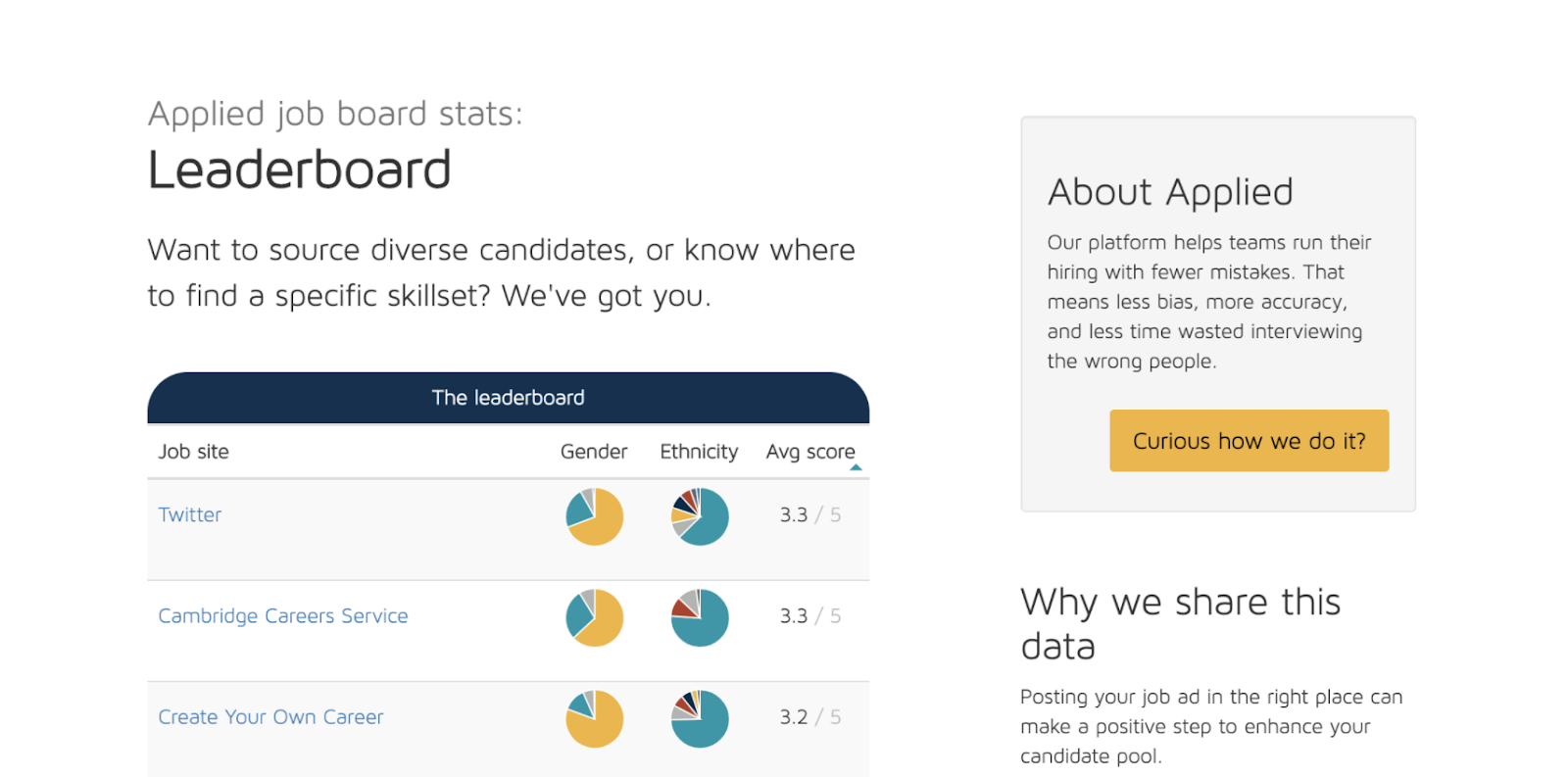
Share on job boards (but use them wisely)
Posting your job on job boards is a no-brainer, but just remember: not all job boards were created equal.
Different job boards will attract different types of candidates.
Our advice: track your job boards like you would your marketing channels.
Below is what our job board tracking looks like in our hiring platform. Whilst we don’t expect you to go this deep into the data, it’s worth keeping tabs on where your best candidates came from.

If diversity is a concern (which it should be!), job board tracking is a lesser-known solution to attracting a more diverse set of candidates.
From our own data, we found that the numbers of male vs female candidates will vary drastically depending on where you post your job.
For example, Advance Careers provided over 82% female applicants, compared to Totaljobs at 74% male.
Want to know which job boards to post your jobs to get better and more diverse candidates? Here are our top-performing job boards:
- Top 5 Job boards for Gender Diversity
- Top 5 Job Boards for Ethnic Diversity
- Top 5 Job Boards for Startup Roles
Share on social media
Advertising job openings across your social media accounts costs nothing and can be surprisingly effective.
Given that mission alignment and pure passion are becoming more sought after than just technical ability, why not share your opening with those who have actually chosen to follow what your organisation is up to?
Plus, your followers may share with their friends that are job seeking.
A few things to bear in mind when posting your job:
- Keep it relatively short
- Specify salary (and any key benefits)
- Be clear about what the person would be working on in the role
- Talk about what it’s like to work at your organisation
Get the team to share
Your team is another cost-free means of getting your job out there.
People trust other real people more than brands, so your team’s posts are likely to get more traction than those posted from the company account.
Their combined networks are also likely to have a wider reach than just your company’s account.
However, a word of warning:
Although 85% of jobs today are filled via networking, you should still be posting your job around...
Relying on networks doesn’t build diverse teams.
Look at candidates you already have
When it comes to advertising a job opening, we tend to think of attracting new people into our pipeline.
But, what if we told you the best person for the job might be a rejected candidate for a past opening?
Just because a candidate wasn’t the right fit for a particular job, doesn’t mean they wouldn’t be the perfect fit for another (which has been the case a few times here at Applied).
When giving candidates feedback at the end of the hiring process, try referring them to any other open roles that they might be better suited to.
We experimented with candidate referrals ourselves, and we found that candidates referred from another role were:
- On average, outperforming regular candidates (by about 15%)
- Almost twice as likely to be ethnically diverse (44% were from a minority heritage, relative to 26% across the board)
- Slightly more gender-balanced (59% female vs 64% female)
Optimise your job description
If you’re not seeing enough applications to your job openings, you might want to look at your job descriptions.
The language you use in your job description affects who applies.
Over-using masculine-coded words will put women off of applying.
This doesn’t make them weak, this is due to the fact that terms like ‘competitive’ or ‘decisive’ signal a certain kind of culture, and a certain type of person who would fit into that culture.
Make sure you actually sell your organisation too. Candidates want to know what their life would be like should they get the job, so put their mind at ease by describing the company’s mission, values, and the general dynamics of the team.
We’ve written an in-depth guide on writing the perfect job description that covers all of the nuances and best practices that will land you a bigger, more diverse candidate pool, but I’ll drop a few key points below...
Guidelines for your job descriptions:
- Stay between 300-800 words
- Ditch the jargon and acronyms
- Aim for gender-neutral gender-coding (we built a tool for this)
- Describe what it’s like to work at your organisation
- List what the new hire would be up to in the first 6 months
- State the salary upfront
We also built this template to help you write high-converting job descriptions with minimal effort, based on behavioural science research.

Applied was designed to help you find the best person for the job, regardless of background. We built behavioural science research into each step of the process, to help you attract and assess talent as efficiently and effectively as possible.
Read more about how we’re changing the hiring game via our free resource library, or start a free trial of the Applied platform to see how it all works

.png)

.png)

